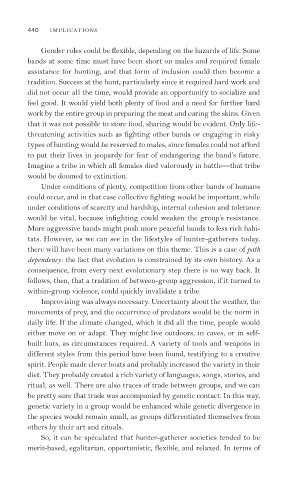Page 475 - Cultures and Organizations
P. 475
440 IMPLICATIONS
Gender roles could be flexible, depending on the hazards of life. Some
bands at some time must have been short on males and required female
assistance for hunting, and that form of inclusion could then become a
tradition. Success at the hunt, particularly since it required hard work and
did not occur all the time, would provide an opportunity to socialize and
feel good. It would yield both plenty of food and a need for further hard
work by the entire group in preparing the meat and curing the skins. Given
that it was not possible to store food, sharing would be evident. Only life-
threatening activities such as fighting other bands or engaging in risky
types of hunting would be reserved to males, since females could not afford
to put their lives in jeopardy for fear of endangering the band’s future.
Imagine a tribe in which all females died valorously in battle—that tribe
would be doomed to extinction.
Under conditions of plenty, competition from other bands of humans
could occur, and in that case collective fighting would be important, while
under conditions of scarcity and hardship, internal cohesion and tolerance
would be vital, because infighting could weaken the group’s resistance.
More aggressive bands might push more peaceful bands to less rich habi-
tats. However, as we can see in the lifestyles of hunter-gatherers today,
there will have been many variations on this theme. This is a case of path
dependency: the fact that evolution is constrained by its own history. As a
consequence, from every next evolutionary step there is no way back. It
follows, then, that a tradition of between-group aggression, if it turned to
within-group violence, could quickly invalidate a tribe.
Improvising was always necessary. Uncertainty about the weather, the
movements of prey, and the occurrence of predators would be the norm in
daily life. If the climate changed, which it did all the time, people would
either move on or adapt. They might live outdoors, in caves, or in self-
built huts, as circumstances required. A variety of tools and weapons in
different styles from this period have been found, testifying to a creative
spirit. People made clever boats and probably increased the variety in their
diet. They probably created a rich variety of languages, songs, stories, and
ritual, as well. There are also traces of trade between groups, and we can
be pretty sure that trade was accompanied by genetic contact. In this way,
genetic variety in a group would be enhanced while genetic divergence in
the species would remain small, as groups differentiated themselves from
others by their art and rituals.
So, it can be speculated that hunter-gatherer societies tended to be
merit-based, egalitarian, opportunistic, flexible, and relaxed. In terms of

